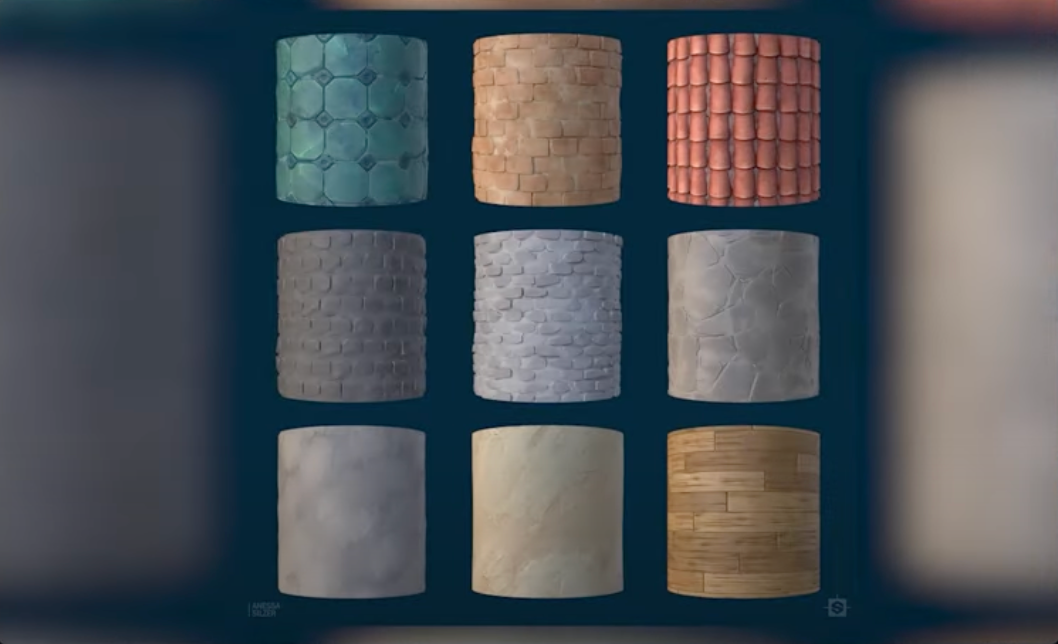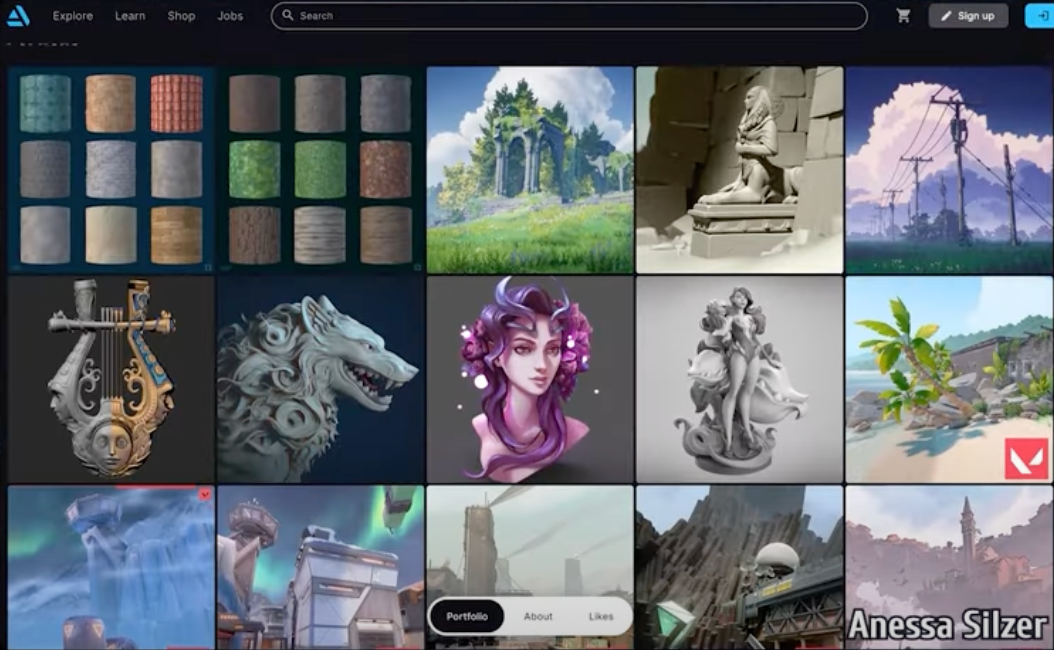If you are an environmental artist or an artist who wants to make your way to becoming an environment artist in the gaming industry, your portfolio is your ticket to showcasing your talent, creativity, and unique vision. Whether you are a 2D or 3D environmental artist, a rockstar art portfolio can open up a world of opportunities.
But how can you do exactly just that?
In this guide, we will show you how to make an art portfolio to stand out from the crowds, complete with inspiring art portfolio examples to get those creative juices flowing.
But first thing first, what exactly does an environment artist do?
Environment artists are the masterminds behind the expansive worlds in games. They create everything from lush forests and sprawling cities to eerie dungeons and fantastical worlds – or it could also be an indoor environment. This can be split into 2D environmental artists (think concept art and matte paintings) and 3D environmental artists (bringing those concepts to life with 3D modeling).
Then, curate some of your best works
Remember, quality over quantity. While you may have tons of artwork you want to show off – or that you are proud of – your art portfolio should only feature your best work, think of something that stands out the most. It would be even better if you could show off various environments where you tackle a whole scene and not just an individual asset.
And while variety is key, don’t forget to let your unique style shine through, and show the works you want to do. Whether you are into hyper-realistic scenes or have a flair for the whimsical and stylized, make sure your portfolio reflects what makes you, well, you.
Share your process
People love to see how the magic happens. Include a few pieces that show your workflow. For 2D environment artists, this could mean showing the journey – even notes – from the initial sketch to the final piece. For 3D environment artists, give a bit of a look into your process.

Show how you start with a concept, develop it into a detailed sketch, and then bring it to life with layers of color and texture. For 3D environment artists, breakdowns showing stages like modeling, UV mapping, texturing, lighting, and final rendering are gold.
Having before-and-after shots can be particularly effective for environment artists. They demonstrate your ability to transform initial concepts into polished final pieces. Show the evolution of a project from rough sketches or block-outs to the finished environment. This not only highlights your technical skills but also your attention to detail and dedication to refining your work.
By doing this, potential clients can get a clear understanding of your vision and workflow as an environment artist. As important as it is to show your technical skills in your art portfolio, you also want to allow potential clients or employers to appreciate the detailed effort and progression involved in bringing the asset to life.
You may want to pay extra attention to the presentation
A well-presented portfolio makes a huge difference. Keep the layout clean and professional, and make it easy to navigate and avoid any visual distractions. High-quality images are a must. If you can successfully present your portfolio in a good way, you will be making a strong first impression. For environmental artists, whether working in 2D or 3D, showcasing your work’s intricate details while maintaining clarity is essential. Preview images play a crucial role here. They offer a snapshot of your capability to potential clients or employers, allowing them to appreciate the meticulous attention to detail that goes into each project. These images should be high-quality and well-lit, ensuring that every nuance and texture is visible and accurately represented.
For environmental artists, whether working in 2D or 3D, showcasing your work’s intricate details while maintaining clarity is essential. Preview images play a crucial role here. They offer a snapshot of your capability to potential clients or employers, allowing them to appreciate the meticulous attention to detail that goes into each project. These images should be high-quality and well-lit, ensuring that every nuance and texture is visible and accurately represented.
Take, for example, a set of props or scenes you are working on. Including images that highlight different aspects — like brick or wooden textures, rust, and material variety — can really bring out your skills as an environment artist.

This will demonstrate your ability to create lifelike, immersive environments while at the same time showcasing your expertise in using various software tools effectively. Whether you are a 3D environmental artist creating detailed game assets or a 2D environmental artist illustrating rich, vibrant scenes, these preview images are your portfolio’s lifeblood.
Ultimately, clarity in your preview images is more than important. It is never about just showing off detailed textures and complex models, but also about presenting them in a way that is easy to interpret and appreciate. Clean, focused shots help convey the depth of your work without overwhelming the viewer. For 3D environmental artists, this might mean highlighting different angles or lighting setups, while 2D environmental artists might focus on various stages of the illustration process.
 An additional point that is useful to note is when presenting weapons, using a dark background and proper lighting is key to highlighting the intricate details of your models. This will add a level of polish to your presentation. Remember to also include renders from the game engine, as these renders provide a realistic preview of how the weapon will appear in-game, offering potential clients or employers a clear view of its final look and functionality within a dynamic environment.
An additional point that is useful to note is when presenting weapons, using a dark background and proper lighting is key to highlighting the intricate details of your models. This will add a level of polish to your presentation. Remember to also include renders from the game engine, as these renders provide a realistic preview of how the weapon will appear in-game, offering potential clients or employers a clear view of its final look and functionality within a dynamic environment.
High-quality renders are a must
 High-quality renders are a must when you’re showing off your work, and capturing your creation from different angles makes a big difference. By doing this, you let potential clients or employers appreciate every detail, texture, and feature of your design.
High-quality renders are a must when you’re showing off your work, and capturing your creation from different angles makes a big difference. By doing this, you let potential clients or employers appreciate every detail, texture, and feature of your design.
This approach is something that should not be missed in fields like 3D modeling and game design, where the visual quality and accuracy of assets can significantly impact the final product. By offering multiple perspectives, you highlight your attention to detail and your ability to create realistic, immersive environments.
We have talked about how to make a rocking art portfolio, but how do you spot a bad one?
First off, an art portfolio with a lack of cohesion. If it feels like you are flipping through a random scrapbook rather than a curated collection, that is a red flag. Also, keep an eye out for outdated or subpar work – showing off your best stuff with varieties is key.
Next, technical hiccups. Blurry images, sloppy formatting, or broken links can make your portfolio a bad art portfolio. And steer clear of those cliché pieces that scream “unoriginal” louder than an alarm clock at dawn.
Many people may not know, but you can avoid making a bad art portfolio by using an art portfolio template. It keeps your work organized and gives it a polished, professional look. So, when you are scrolling through art portfolios, keep these tips in mind to steer clear of the bad art portfolio examples and make yours the good one.
So, now that you know what to add to your art portfolio, the question is, what do game studios look for in an environment artist?
A solid modeling and texturing portfolio that includes a variety of assets, such as terrain, vegetation, and buildings. The more themes you cover, the better. Show different settings like forests, urban areas, and interiors. This variety will point out your technical skills as well as your creativity and ability to work on different types of projects.
Creating environments involves more than just making models, it also includes set dressing and layout. Knowing how to use scattering tools is important for adding realistic details like plants, debris, and small objects that make a scene feel real.
Many game studios want to see your artistic direction and how you handle your creative process. This includes gathering references and making design decisions. Jeremy Fenske, Art Director from Singularity added, “I also like to see an artist that is flexible, that isn’t stuck in one style.”
So when it comes to art portfolio, it is all about being adaptable and willing to explore different styles and approaches. Showing versatility in your portfolio can really make you stand out in the competitive world of game development.
At Devoted CG, we are all about helping environment artists like you shine
Ready to take your portfolio to the next level? At Devoted CG, we are all about helping environment artists like you shine, we believe that every artist deserves the best. Register for free and get the chance to work on amazing game projects! Our platform connects talented environment artists with top gaming companies, giving you a space to showcase your work and get noticed. Don’t miss out – make your portfolio shine on Devoted CG!
At Devoted CG, we envision a world where everyone, regardless of location or work style (even in pajamas!), has equal opportunities to contribute to amazing games.
 Through our innovative artist-to-project matching system, we level the playing field, fostering success for individuals from diverse backgrounds and enabling teams to effortlessly build a well-rounded workforce. Every professional on Devoted CG enjoys equal access to growth and achievement.
Through our innovative artist-to-project matching system, we level the playing field, fostering success for individuals from diverse backgrounds and enabling teams to effortlessly build a well-rounded workforce. Every professional on Devoted CG enjoys equal access to growth and achievement.

